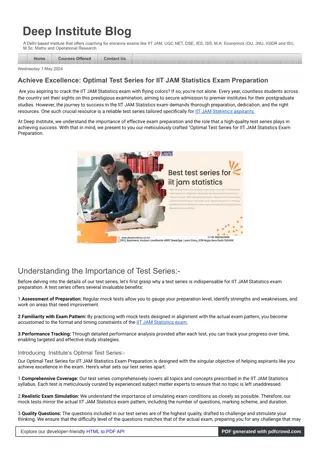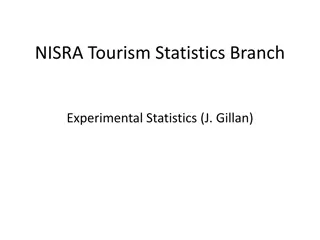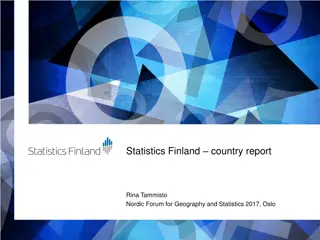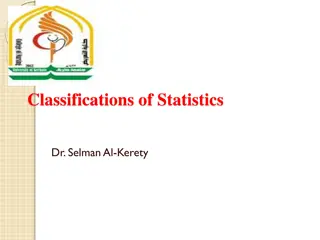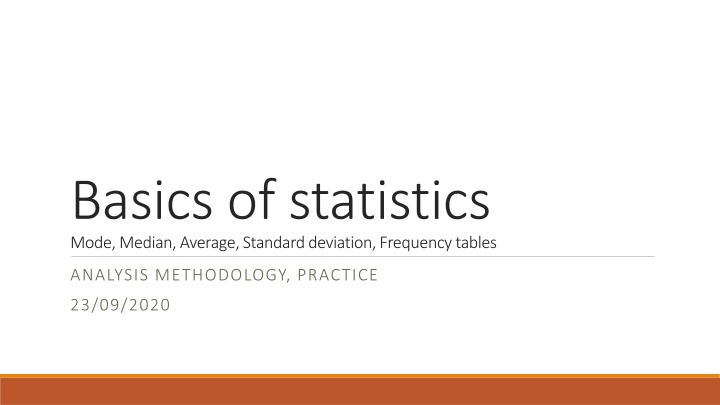
Statistics: Mode, Median, Average, Standard Deviation & Frequency Tables
Learn the basics of statistics including calculating mode, median, average, standard deviation, and creating frequency tables with practical examples and analysis methodology. Explore the concepts of central tendency and data distribution in detail.
Download Presentation

Please find below an Image/Link to download the presentation.
The content on the website is provided AS IS for your information and personal use only. It may not be sold, licensed, or shared on other websites without obtaining consent from the author. If you encounter any issues during the download, it is possible that the publisher has removed the file from their server.
You are allowed to download the files provided on this website for personal or commercial use, subject to the condition that they are used lawfully. All files are the property of their respective owners.
The content on the website is provided AS IS for your information and personal use only. It may not be sold, licensed, or shared on other websites without obtaining consent from the author.
E N D
Presentation Transcript
Basics of statistics Mode, Median, Average, Standard deviation, Frequencytables ANALYSIS METHODOLOGY, PRACTICE 23/09/2020
Mode The mode is the value that appears most often in a set of data values. The mode is not necessarily unique. Example 1 Dataset: x={1, 2, 2, 3, 4, 7, 9} Most frequent element: 2 Example 2 Dataset: x={1, 2, 2, 3, 3, 7, 9} Most frequent element: 2, 3 mode is not unique! Example 3 Dataset: x={1, 2, 3, 4, 7, 8, 9} Every element is equally frequent there is no mode (or every element is the mode) 2
Median The median is a value separating the higher half from the lower half of a data sample or population. The median is not necessarily unique. To find the median, the data should be sorted in ascending order. Example 1 Dataset: x={1, 2, 2, 3, 4, 7, 9} Median: 3 Example 2.1 Dataset: x={1, 2, 4, 8, 9, 17} Median: 4, 8 median is not unique! Example 2.2 Dataset: x={1, 2, 4, 8, 9, 17} Median: (4+8)/2=6 also acceptable 3
Average, Standard deviation We have a dataset: x={x1,x2, ,xN}, where N is the number of elements of x. The average of the dataset: ? ? = ?=1 ?? ? The standard deviation of the dataset: ?( ? ??)2 ? 1 ?=1 ? = For greater samples (N>30) or populations: ?( ??)2 ? ?=1 = 4
Average, Standard deviation Calculate the average, and the standard deviation of the following dataset: x={1, 2, 2, 3, 4, 7, 9}! 5
Frequency tables The frequency of an event (i) is the number (fi) of times the event occured in an experiment or study. Example 1: weighted average and weighted standard deviation. The exam results of N=12 students are summarized in a frequency table Average of the marks: ? ?? ? 12 ?=1 ???? ?=1 ?? ?=1 =5+5+5+4+4+4+4+3+3+2+2+1 =3 5+4 4+2 3+2 2+1 1 =?5?5+?4?4+?3?3+?2?2+?1?1 ? = 12 ? 5 Weighted average: ? = Number of students with mark m = fm 3 Mark = m 5 5 ??(?? ?)2 ( ?=1 ??) 1 ?=1 m5=5 m4=4 m3=3 m2=2 m1=1 Weighted standard deviation: ? = 5 4 2 2 1 6
Frequency tables Sometimes we do not have a complete dataset! Example: heights of people sorted in to a frequency table We do not have the value of the height of every people We know how many people are in a certain interval, but there heights can be anything between the inverval min and max Min (cm) Max (cm) Frequency Center of interval We assign a value to each person: this value is the center of the interval (the average of min and max) 150 160 14 155 160 170 65 165 170 180 143 175 180 190 88 185 190 200 22 195 7


